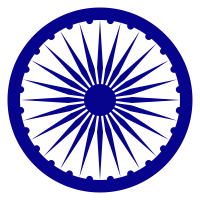Ashoka Chakra
- This article is about Ashoka Chakra, a symbol. For information about Ashoka Chakra the Award, see Ashoka Chakra Award

The Ashoka Chakra is a depiction of the Dharmachakra, the Wheel of Dharma (Sanskrit: Chakra means wheel). The wheel has 24 spokes.
The Ashoka Chakra has been widely inscribed on many relics of the Mauryan Emperor Ashoka The Great (Reigned 273-232 BCE), most prominent among which is the Lion Capital of Sarnath and The Ashoka Pillar.
The most visible use of the Ashoka Chakra today is at the centre of the National flag of the Republic of India (adopted on 22 July, 1947), where it is rendered in a Navy-blue color on a White background, by replacing the symbol of Charkha (Spinning wheel) of the pre-independence versions of the flag. Ashoka Chakra can also been seen on the base of Lion Capital of Ashoka which has been adopted as the National Emblem of India.
History and reason behind design
The Ashoka chakra was built by the Indian emperor Ashoka the Great in his reign. Chakra is a Sanskrit word which also means cycle or self repeating process. The process it signifies is the cycle of time as how the world changes with time. The horse means accuracy and speed while the bull means hardwork.
The twenty four spokes in this chakra wheel represent twenty four virtues:
- Love
- Courage
- Patience
- Peacefulness
- Kindness
- Goodness
- Faithfulness
- Gentleness
- Self-control
- Selflessness
- Self sacrifice
- Truthfulness
- Righteousness
- Justice
- Mercy
- Graciousness
- Humility
- Empathy
- Sympathy
- Godly knowledge
- Godly wisdom
- Godly moral
- Reverential fear of God
- Hope/trust/faith in the goodness of God.
